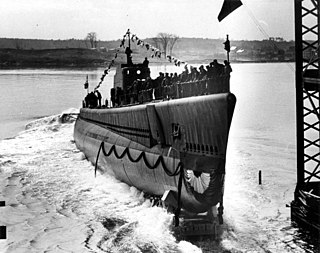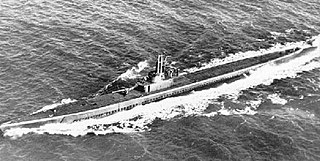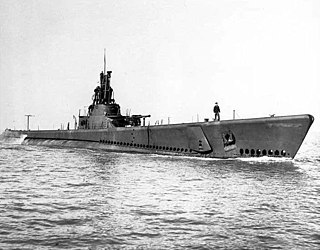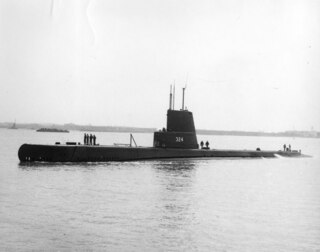
USS Bonefish (SS-223) was a Gato-class submarine, the first United States Navy ship to be named for the bonefish.

USS Snook (SS-279), a Gato-class submarine, was the first ship of the United States Navy to be named for the common snook, an Atlantic marine fish that is bluish-gray above and silvery below a black lateral line.

USS Drum (SS-228) is a Gato-class submarine of the United States Navy, the first Navy ship named after the drum, a type of fish. Drum is a museum ship in Mobile, Alabama, at Battleship Memorial Park.

USS Finback (SS-230), a Gato-class submarine, was the first ship of the United States Navy to be named for the finback. Nine of Finback's twelve World War II patrols in the Pacific were designated as "successful"; she received 13 battle stars for her service and is credited with having sunk nearly 70 thousand tons of enemy shipping.

USS Skipjack (SS-184), was a Salmon-class submarine, the second ship of the United States Navy to be named after the skipjack tuna. She earned multiple battle stars during World War II and then was sunk, remarkably, by an atomic bomb during post-World War II testing in Operation Crossroads. Among the most "thoroughly sunk" ships, she was refloated and then sunk a second time as a target ship two years later.

USS Snapper (SS-185), a Salmon-class submarine, was the third ship of the United States Navy of the name and the second to be named for the snapper.

USS Kingfish (SS-234), a Gato-class submarine, was the first ship of the United States Navy to be named for the kingfish.

USS Flasher (SS-249) was a Gato-class submarine which served in the Pacific during World War II. She received the Presidential Unit Citation and six battle stars, and sank 21 ships for a total of 100,231 tons of Japanese shipping, making her one of the most successful American submarines of the War. She was the first ship of the United States Navy to be named for the flasher.

USS Jack (SS-259), a Gato-class submarine, was the first ship of the United States Navy to be named for the jack.

USS Muskallunge (SS-262), a Gato-class submarine, was a ship of the United States Navy named for the muskallunge.

USS Paddle (SS-263), a Gato-class submarine, was a ship of the United States Navy named for the paddlefish.

USS Pogy (SS-266), a Gato-class submarine, was the first ship of the United States Navy to be named for the pogy, or menhaden. She was credited with sinking 16 ships totaling 62,633 gross register tons during World War II.

USS Raton (SS/SSR/AGSS-270), a Gato-class submarine, was a ship of the United States Navy named for the raton, a polynemoid fish inhabiting semitropical waters off the Pacific coast of the Americas.

USS Ray (SS/SSR-271), a Gato-class submarine, was the first ship of the United States Navy to be named for the ray, a fish characterized by a flat body, large pectoral fins, and a whiplike tail.

USS Sawfish (SS-276), a Gato-class submarine, was a ship of the United States Navy named for the sawfish, a viviparous ray which has a long flat snout with a row of toothlike structures along each edge. It is found principally in the mouths of tropical American and African rivers.

The first USS Sunfish (SS-281), a Gato-class submarine, was the first ship of the United States Navy to be named for the ocean sunfish, Mola mola, a plectognath marine fish, having a deep body truncated behind, and high dorsal and anal fins.

USS Seahorse (SS-304), a Balao-class submarine, was the first submarine and second ship of the United States Navy to be named for the seahorse, a small fish whose head and the fore part of its body suggest the head and neck of a horse.

USS Blenny (SS/AGSS-324), a Balao-class submarine in commission from 1944 to 1969, was a ship of the United States Navy named for the blenny, a fish found along the rocky shores of the Atlantic Ocean. During World War II, Blenny conducted four war patrols in the Java Sea and South China Sea between 10 November 1944 and 14 August 1945. She sank eight Japanese vessels totaling 18,262 tons. In addition, she is credited with destroying more than 62 miscellaneous Japanese small craft by gunfire.

USS Hammerhead (SS-364), a Gato-class submarine, was the first ship of the United States Navy to be named for the hammerhead shark, a shark found in warm seas with a flattened anterior forward of the gill slits, presenting a hammer-like silhouette when viewed from above.

USS Pintado (SS-387/AGSS-387), a Balao-class submarine, was the first ship of the United States Navy to be named for the pintado.























